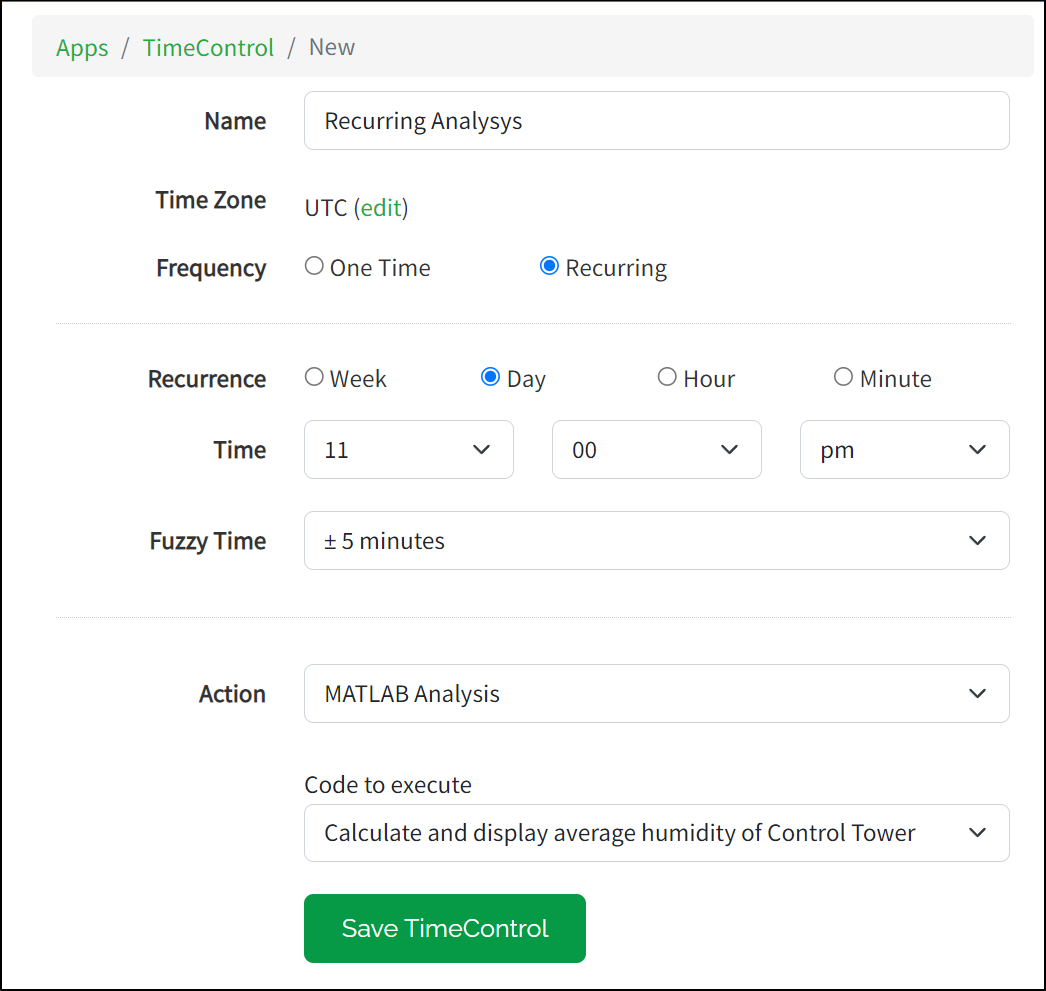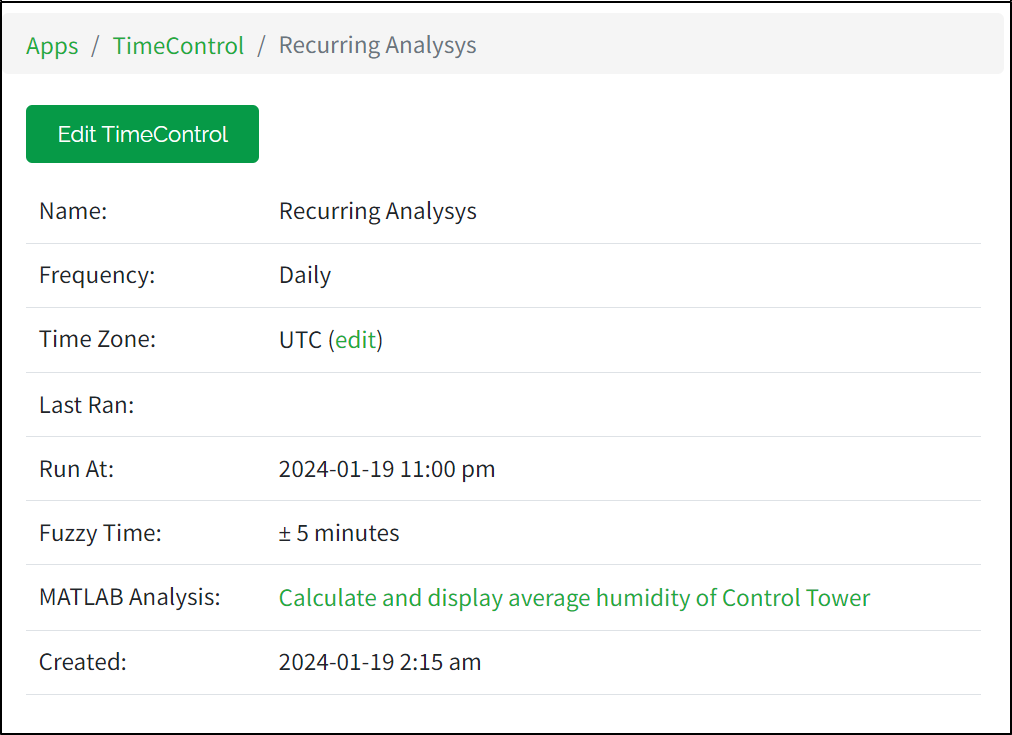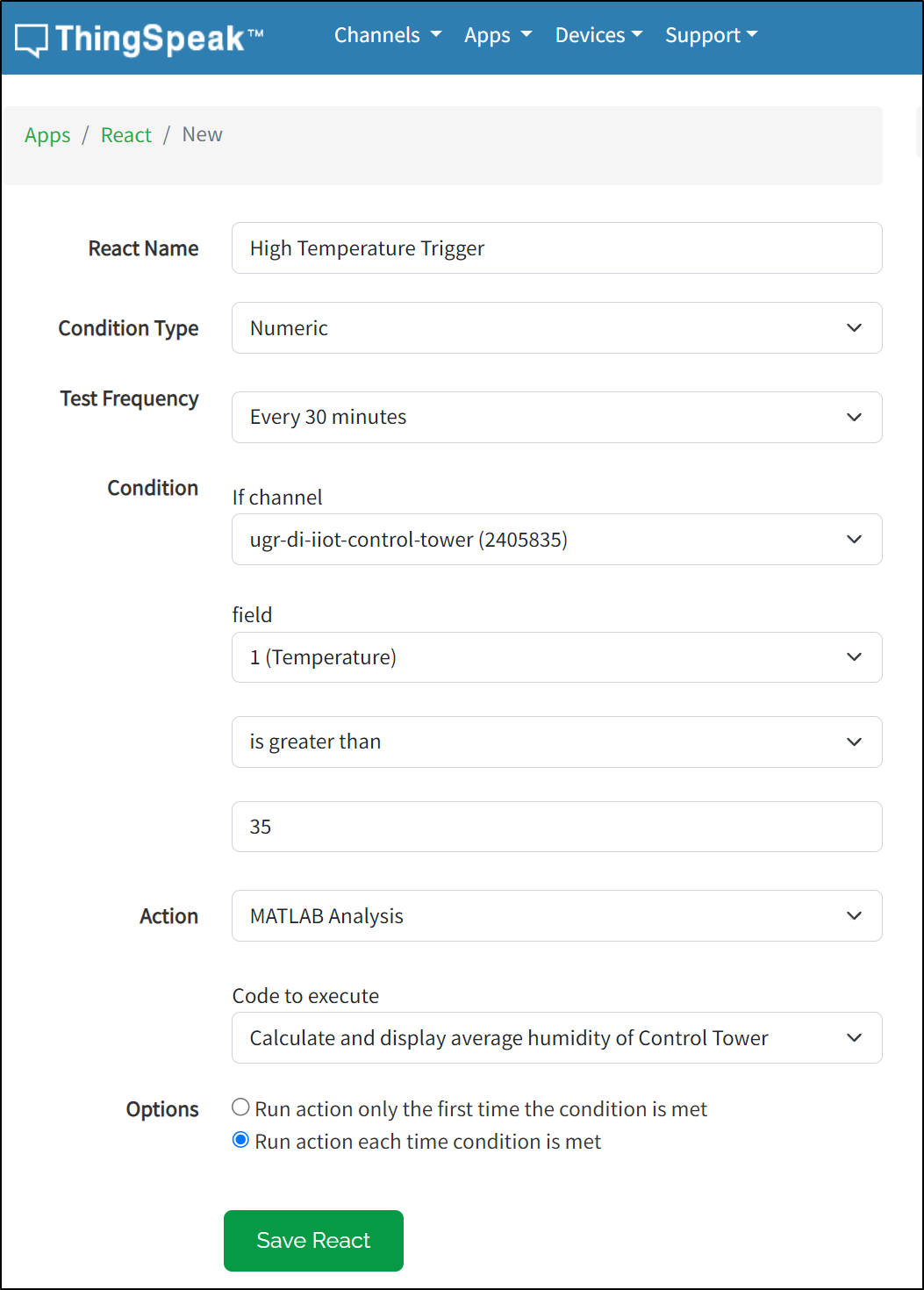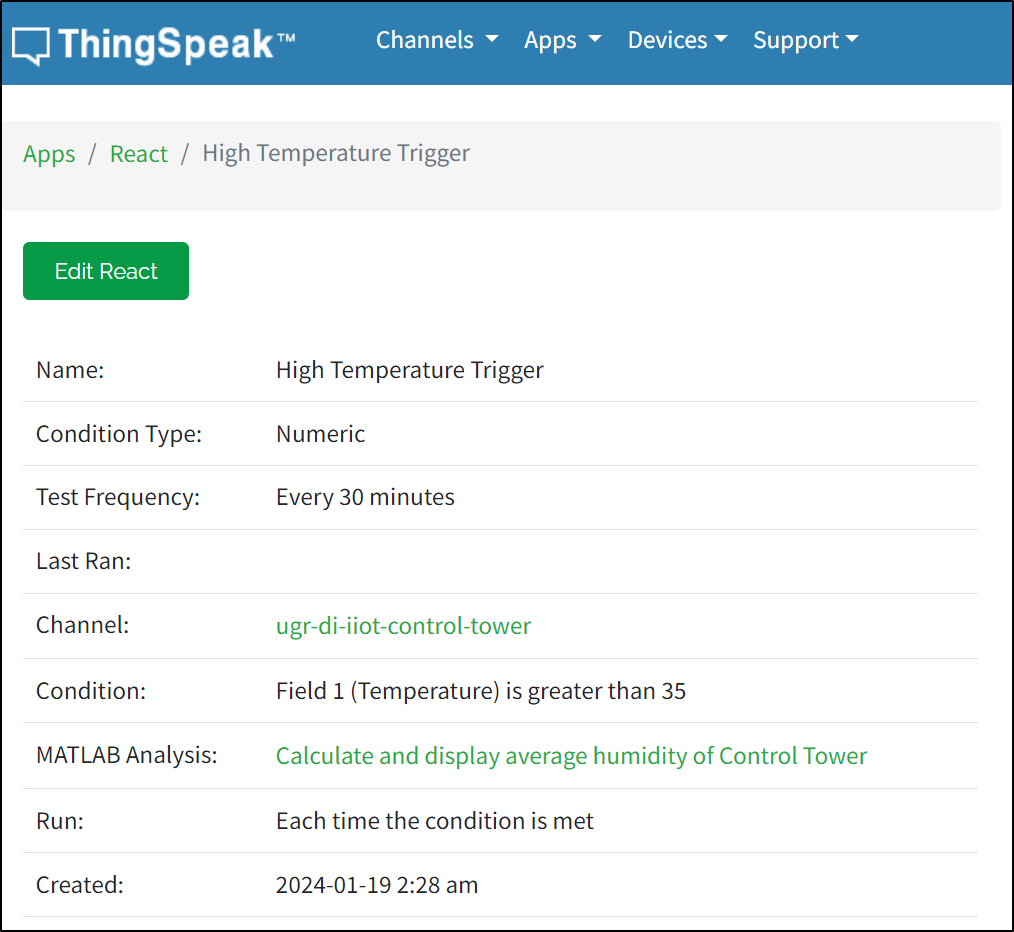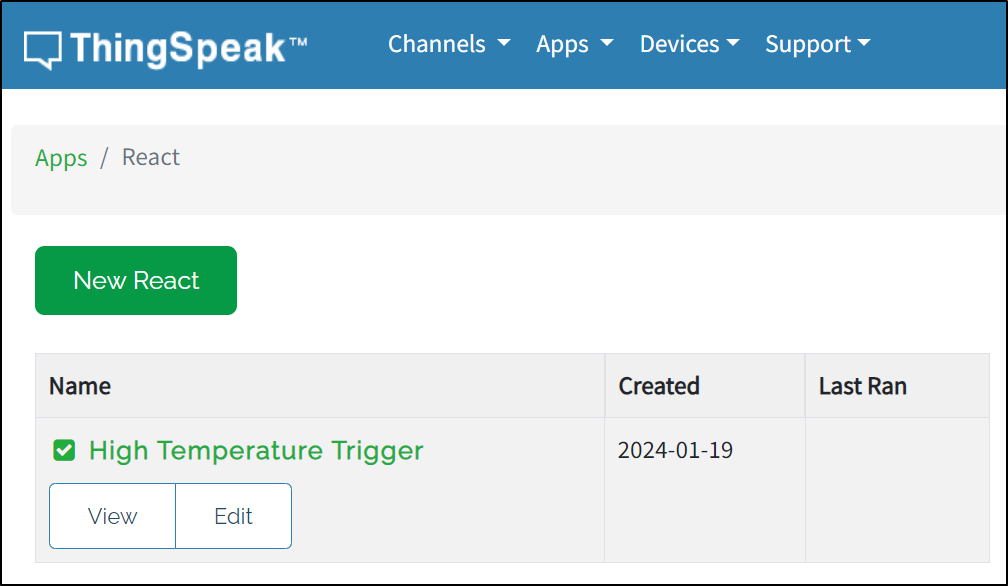Recently, I’ve started to learn about IoT, which is outstanding. I really enjoy working with small devices, connecting sensors, soldering, and measuring clocks. And gather everything in a device that does great things with a tiny amount of power and not a very performant network connection.
So, that’s cool, but what if we don’t have devices, or can’t solder? Personally, I’d like not to waste my Arduino or Raspberry Pico doing something wrong. And anyway, it’s good planning first. And there is a way! You will need the ThingSpeak platform from MathWorks, Wokwi, and Imagination. Let’s start.
Thinking a bit, I decided to create a Smart Recreation Site. To bring my simulated project to reality, I’ve downloaded a cool map of Seaport Village (I hope they don’t mind) and placed some Smart things here and there.
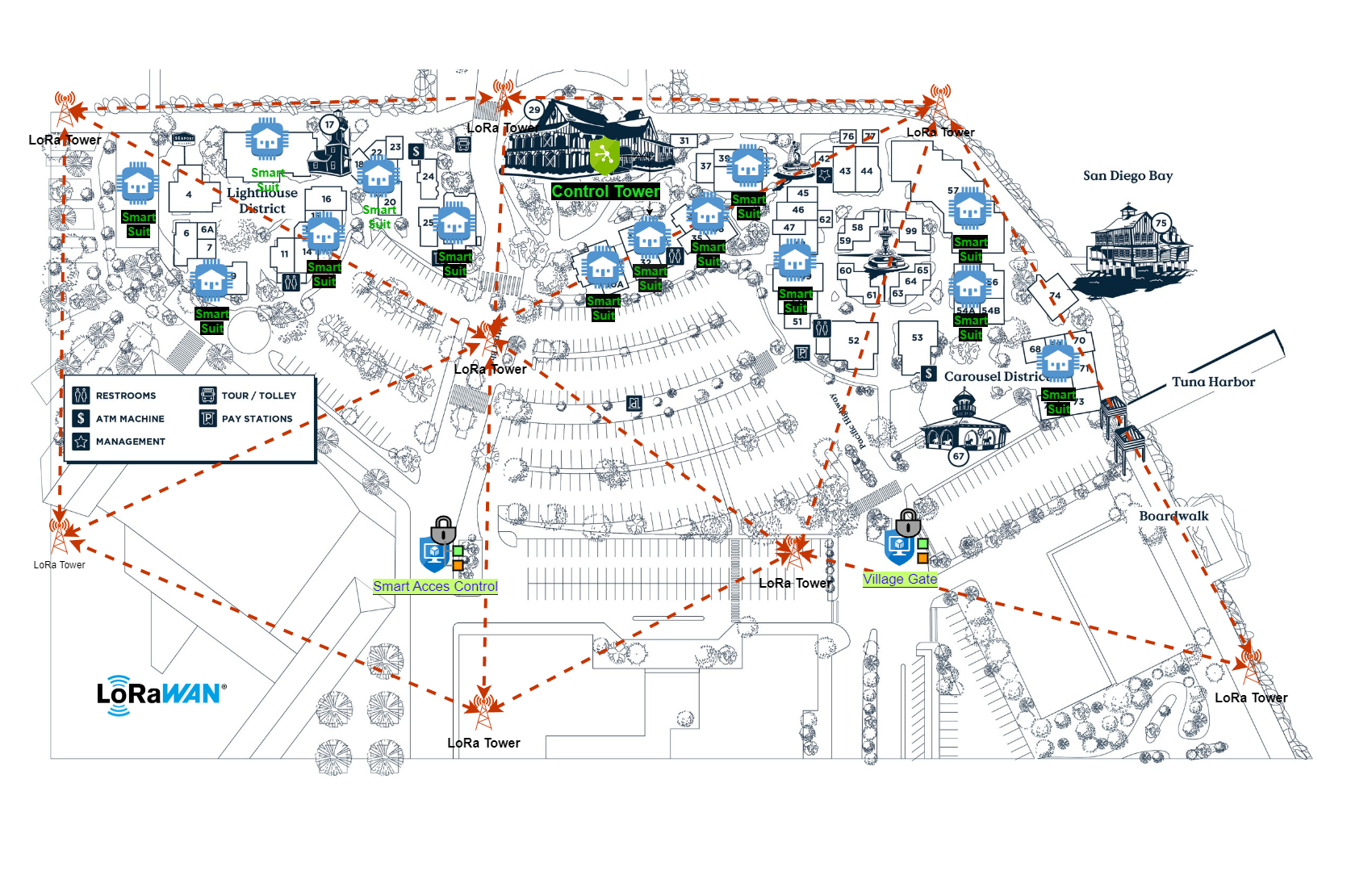
| Device Name | Metrics | Description |
|---|---|---|
| Control Tower | Temperature, Humidity, Weaher Quality | Logical centre of the village |
| Smart Suite | Temperature, Humidity, Rooms | Recreation point |
| Village Gate | Temperature, Humidity, Lights, Servo | Access-control point |
Let’s create a couple of channels in ThingSpeak. I will need three channels for smart devices and one for analytics, but I won’t cover analytics on a decent level here.
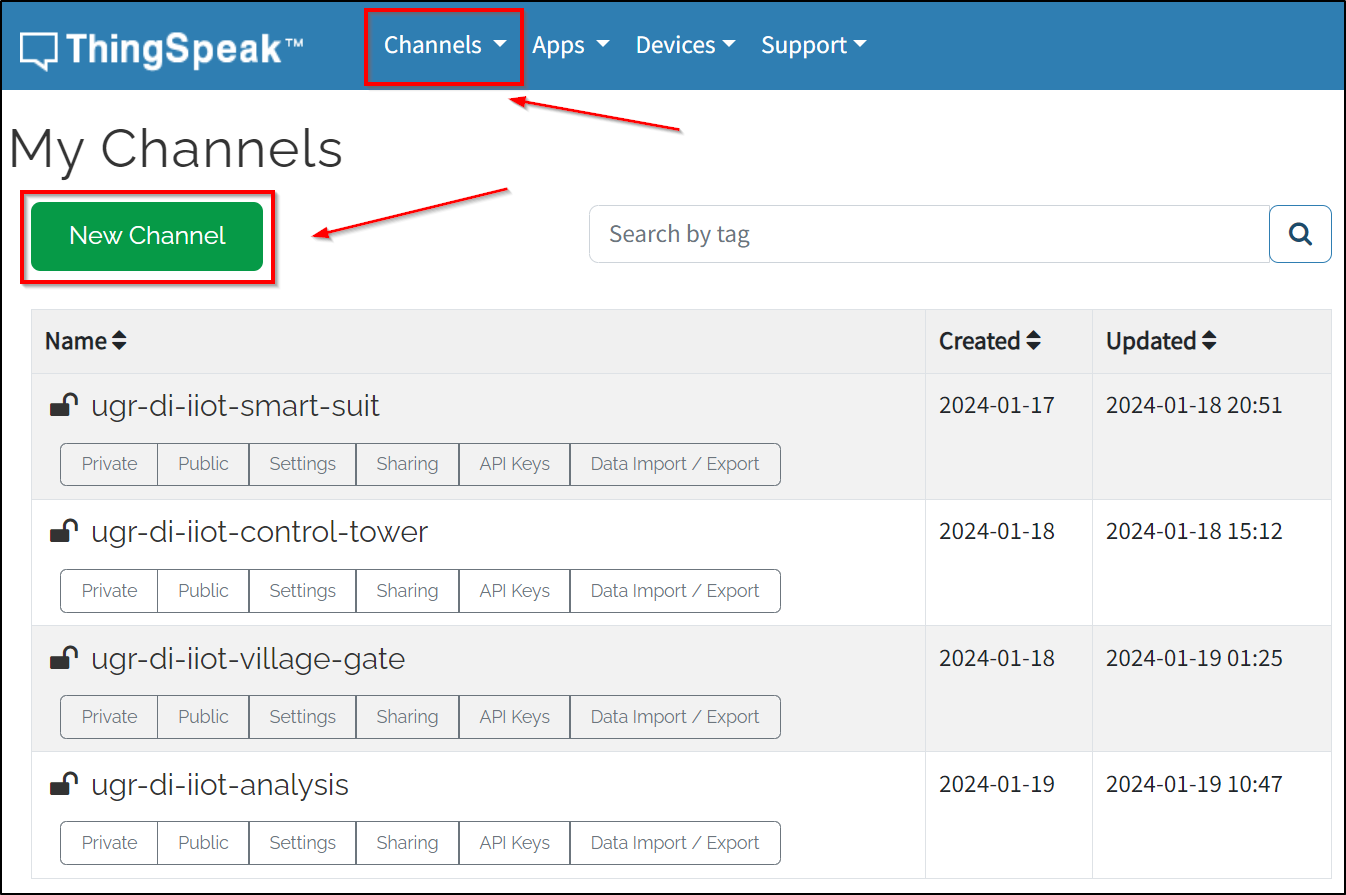
Then, let’s define devices and metrics.
The Control Tower has basic sensors, generic for a whole site. The sensor implementation is based on the ESP32 platform with DHT22 (Digital Temperature and Humidity Sensor) and LED for indication of dangerous weather.
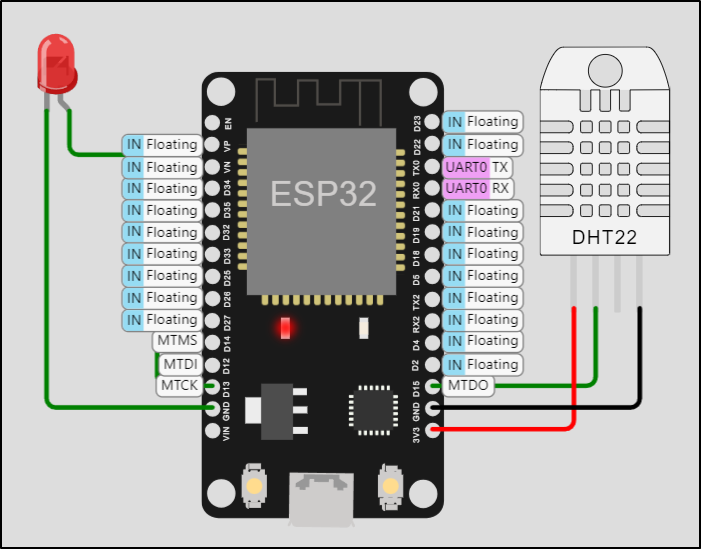
#include <WiFi.h>
#include "DHTesp.h"
#include "ThingSpeak.h"
const int DHT_PIN = 15;
const int LED_PIN = 13;
const char *WIFI_NAME = "Wokwi-GUEST";
const char *WIFI_PASSWORD = "";
const int myChannelNumber = 2405835;
const char *myApiKey = "26R51XI1UJXRM4IF";
const char *server = "api.thingspeak.com";
DHTesp dhtSensor;
WiFiClient client;
void setup() {
Serial.begin(115200);
dhtSensor.setup(DHT_PIN, DHTesp::DHT22);
pinMode(LED_PIN, OUTPUT);
WiFi.begin(WIFI_NAME, WIFI_PASSWORD);
while (WiFi.status() != WL_CONNECTED) {
delay(1000);
Serial.println("Wifi not connected");
}
Serial.println("Wifi connected !");
Serial.println("Local IP: " + String(WiFi.localIP()));
WiFi.mode(WIFI_STA);
ThingSpeak.begin(client);
}
void loop() {
TempAndHumidity data = dhtSensor.getTempAndHumidity();
ThingSpeak.setField(1, data.temperature);
ThingSpeak.setField(2, data.humidity);
if (data.temperature > 40 || data.temperature < 0 || data.humidity > 80 || data.humidity < 10) {
ThingSpeak.setField(3, 1);
digitalWrite(LED_PIN, HIGH);
} else {
ThingSpeak.setField(3, 0);
digitalWrite(LED_PIN, LOW);
}
int x = ThingSpeak.writeFields(myChannelNumber, myApiKey);
Serial.println("Temperature: " + String(data.temperature, 2) + "°C");
Serial.println("Humidity: " + String(data.humidity, 1) + "%");
if (x == 200) {
Serial.println("Data pushed successfull");
} else {
Serial.println("Push error" + String(x));
}
Serial.println("====================");
delay(10000);
}
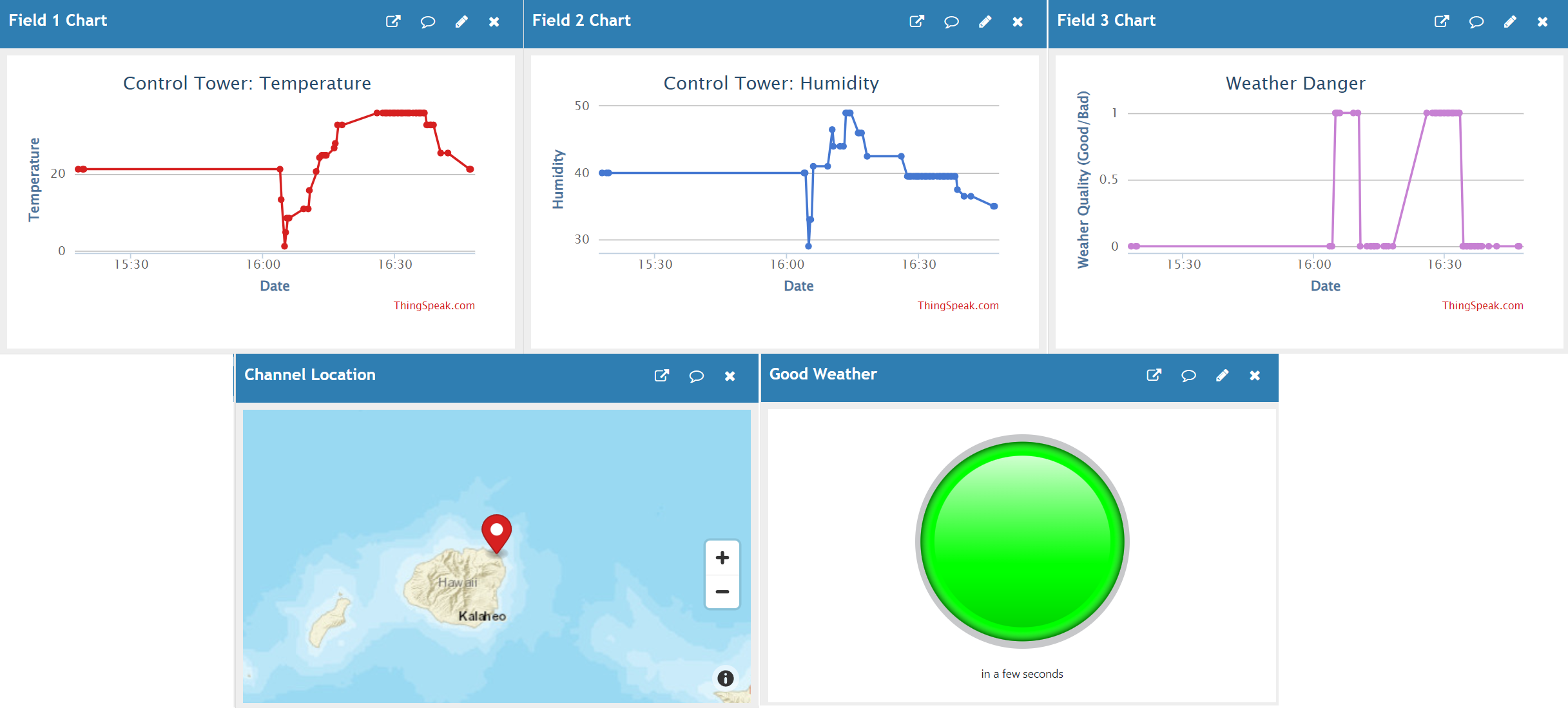
The Smart Suit has sensors to control the environment. The temperature sensor automatically enables the Heater, and the motion sensors control living spaces. The sensor implementation is based on the ESP32 platform with DHT22 (Digital Temperature and Humidity Sensor), Relays, and Motion sensors. LEDs serve to indicate enabled relays.
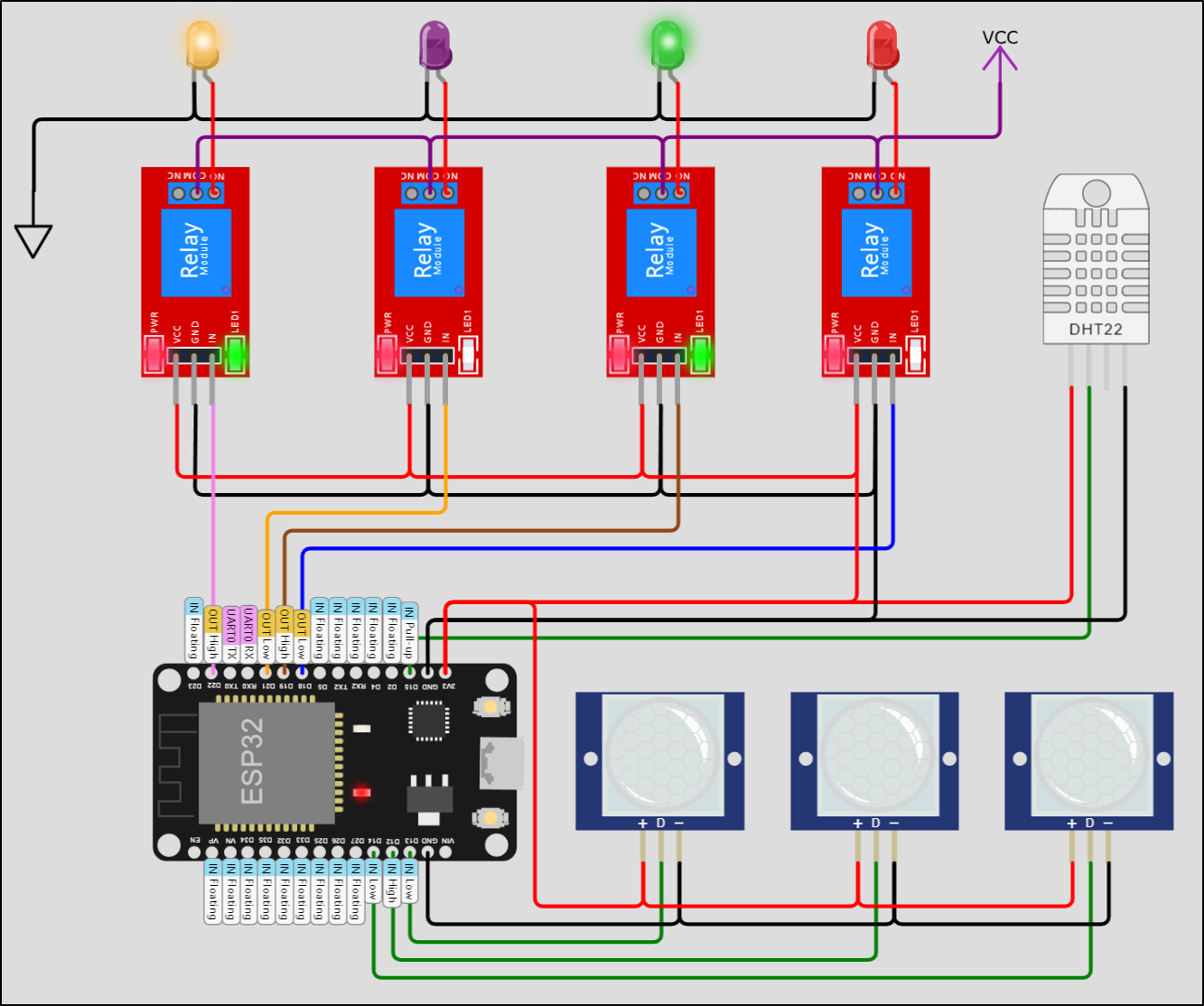
#include <WiFi.h>
#include "DHTesp.h"
#include "ThingSpeak.h"
// Wifi
const char *WIFI_NAME = "Wokwi-GUEST";
const char *WIFI_PASSWORD = "";
WiFiClient client;
// Thingspeak
unsigned long weatherStationChannelNumber = 2405104;
unsigned long myChannelNumber = 2405104;
const char *myWriteAPIKey = "3SGUAWSLXUEL6CIP";
// Pins
const int dhtPin = 15;
const int chHeaterPin = 22;
const int chKitchenPin = 21;
const int chGardenPin = 19;
const int chLivingroomPin = 18;
;
const int pirKitchenPin = 13;
const int pirGardenPin = 12;
const int pirLivingroomPin = 14;
DHTesp dhtSensor;
// Timer variables
unsigned long lastTime = 0;
unsigned long timerDelay = 10000;
int statusCode = 0;
int field[8] = {1, 2, 3, 4};
int chHeater = 0;
int chKitchen = 0;
int chGarden = 0;
int chLivingroom = 0;
float prevTemp = 0;
void setup()
{
Serial.begin(115200); // Initialize serial
dhtSensor.setup(dhtPin, DHTesp::DHT22);
pinMode(chHeaterPin, OUTPUT);
pinMode(chKitchenPin, OUTPUT);
pinMode(chGardenPin, OUTPUT);
pinMode(chLivingroomPin, OUTPUT);
pinMode(pirKitchenPin, INPUT);
pinMode(pirGardenPin, INPUT);
pinMode(pirLivingroomPin, INPUT);
WiFi.begin(WIFI_NAME, WIFI_PASSWORD);
while (WiFi.status() != WL_CONNECTED)
{
delay(1000);
Serial.println("Wifi not connected");
}
Serial.println("Wifi connected !");
Serial.println("Local IP: " + String(WiFi.localIP()));
WiFi.mode(WIFI_STA);
ThingSpeak.begin(client);
Serial.println("Welcome at Smart Suite");
}
void loop()
{
// use ThingSpeak.readMultipleFields(channelNumber, readAPIKey) for private channels
statusCode = ThingSpeak.readMultipleFields(weatherStationChannelNumber);
if (statusCode == 200)
{
// Fetch the stored data
chHeater = ThingSpeak.getFieldAsInt(field[2]); // Field 3
chKitchen = ThingSpeak.getFieldAsInt(field[3]); // Field 4
chGarden = ThingSpeak.getFieldAsInt(field[4]); // Field 5
chLivingroom = ThingSpeak.getFieldAsInt(field[5]); // Field 6
}
else
{
Serial.println("Problem reading channel. HTTP error code " + String(statusCode));
}
TempAndHumidity dhtData = dhtSensor.getTempAndHumidity();
float temperature = dhtData.temperature;
float humidity = dhtData.humidity;
if (temperature < 19)
chHeater = 1;
else
chHeater = 0;
if (digitalRead(pirKitchenPin) == HIGH)
chKitchen = 1;
else
chKitchen = 0;
if (digitalRead(pirGardenPin) == HIGH)
chGarden = 1;
else
chGarden = 0;
if (digitalRead(pirLivingroomPin) == HIGH)
chLivingroom = 1;
else
chLivingroom = 0;
if (chHeater >= 1)
digitalWrite(chHeater, HIGH);
if (chHeater == 0)
digitalWrite(chHeater, LOW);
if (chKitchen >= 1)
digitalWrite(chKitchen, HIGH);
if (chKitchen == 0)
digitalWrite(chKitchen, LOW);
if (chGarden >= 1)
digitalWrite(chGarden, HIGH);
if (chGarden == 0)
digitalWrite(chGarden, LOW);
if (chLivingroom >= 1)
digitalWrite(chLivingroom, HIGH);
if (chLivingroom == 0)
digitalWrite(chLivingroom, LOW);
Serial.println("Temperature: " + String(temperature));
Serial.println("Humidity: " + String(humidity));
Serial.println("Heater: " + String(chHeater));
Serial.println("Kitchen: " + String(chKitchen));
Serial.println("Garden: " + String(chGarden));
Serial.println("Livingroom: " + String(chLivingroom));
ThingSpeak.setField(1, temperature);
ThingSpeak.setField(2, humidity);
ThingSpeak.setField(3, chHeater);
ThingSpeak.setField(4, chKitchen);
ThingSpeak.setField(5, chGarden);
ThingSpeak.setField(6, chLivingroom);
// Write to ThingSpeak.
int x = ThingSpeak.writeFields(myChannelNumber, myWriteAPIKey);
if (x == 200)
Serial.println("Data pushed successfull");
else
Serial.println("Push error" + String(x));
Serial.println("====================");
delay(10000);
}

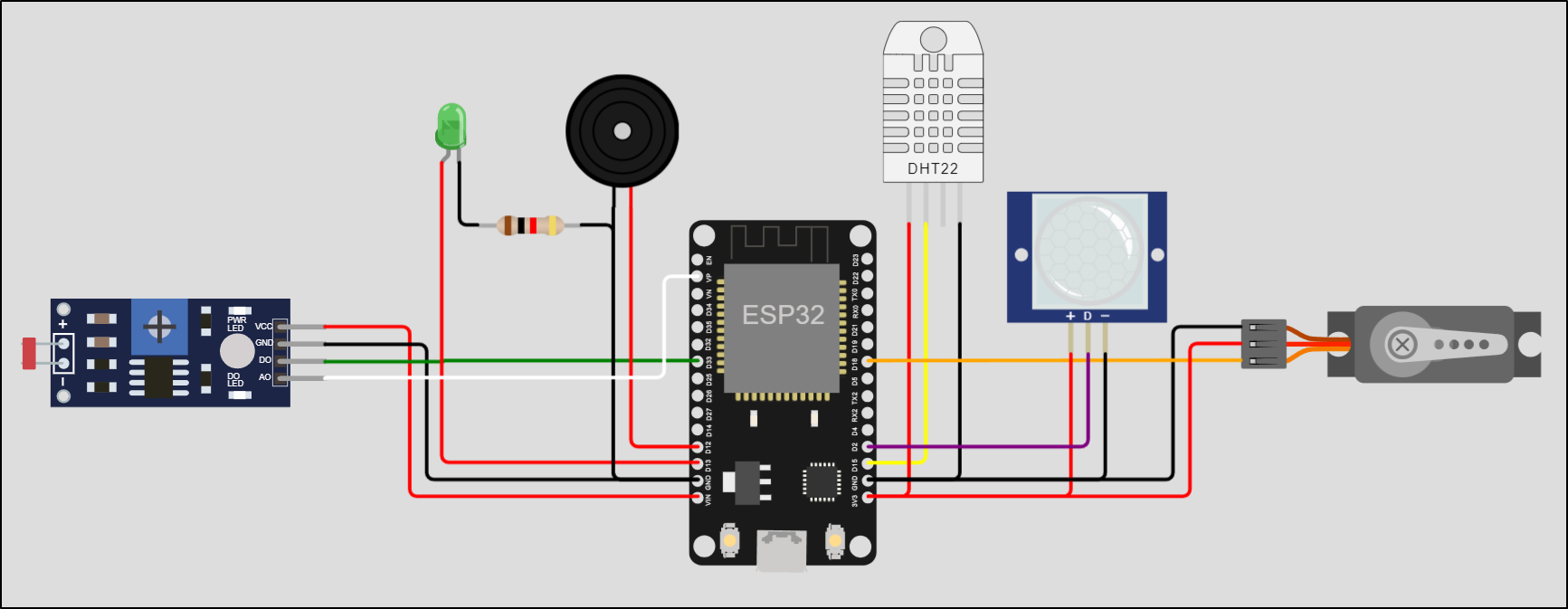
#include <WiFi.h>
#include <DHTesp.h>
#include <ESP32Servo.h>
#include <HTTPClient.h>
#include <ThingSpeak.h>
// Wifi
const char *WIFI_NAME = "Wokwi-GUEST";
const char *WIFI_PASSWORD = "";
// Thingspeak
unsigned long myChannelNumber = 2405836;
const char *myAPIKey = "DJ8PF7L6ASVSGZXN";
// Pins
const int pirPin = 2; // pir
const int beeperPin = 12;
const int ledPin = 13;
const int dhtPin = 15;
const int servoPin = 18;
const int photoresistorAnalogPin = A0;
const int photoresistorDigitalPin = 33;
// Variables
const float GAMMA = 0.7;
const float RL10 = 50;
int day = 0;
int pos = 0;
Servo servo;
WiFiClient client;
DHTesp dhtSensor;
void setup()
{
Serial.begin(115200);
dhtSensor.setup(dhtPin, DHTesp::DHT22);
pinMode(ledPin, OUTPUT);
pinMode(beeperPin, OUTPUT);
pinMode(pirPin, INPUT);
pinMode(photoresistorAnalogPin, INPUT);
servo.attach(servoPin, 500, 2400);
WiFi.begin(WIFI_NAME, WIFI_PASSWORD);
while (WiFi.status() != WL_CONNECTED)
{
delay(1000);
Serial.println("Wifi not connected");
}
Serial.println("Wifi connected !");
Serial.println("Local IP: " + String(WiFi.localIP()));
WiFi.mode(WIFI_STA);
ThingSpeak.begin(client);
}
void loop()
{
TempAndHumidity data = dhtSensor.getTempAndHumidity();
String temperature = String(data.temperature, 2);
String humidity = String(data.humidity, 2);
// Photoresistor
float valueLDR = analogRead(photoresistorAnalogPin);
valueLDR = map(valueLDR, 4095, 0, 1024, 0);
float voltage = valueLDR / 1024. * 5;
float resistance = 2000 * voltage / (1 - voltage / 5);
float lux = pow(RL10 * 1e3 * pow(10, GAMMA) / resistance, (1 / GAMMA));
day = digitalRead(photoresistorDigitalPin);
Serial.println("Temperature: " + String(temperature));
Serial.println("Humidity: " + String(humidity));
Serial.println("Light: " + String(lux));
Serial.println("Day: " + String(day));
// Moution Sensor and Beeper
if (digitalRead(pirPin) == HIGH) {
Serial.println("Opening Gates");
ThingSpeak.setField(4, 1);
digitalWrite(beeperPin, HIGH);
while (pos <= 180) {
servo.write(pos);
delay(15);
pos++;
}
} else {
Serial.println("Closing Gates");
ThingSpeak.setField(4, 0);
digitalWrite(beeperPin, LOW);
while (pos >= 0) {
servo.write(pos);
delay(15);
pos--;
}
}
ThingSpeak.setField(1, temperature);
ThingSpeak.setField(2, humidity);
ThingSpeak.setField(3, lux);
// Write to ThingSpeak.
int x = ThingSpeak.writeFields(myChannelNumber, myAPIKey);
if (x == 200)
Serial.println("Data pushed successfull");
else
Serial.println("Push error" + String(x));
Serial.println("====================");
delay(100);
}
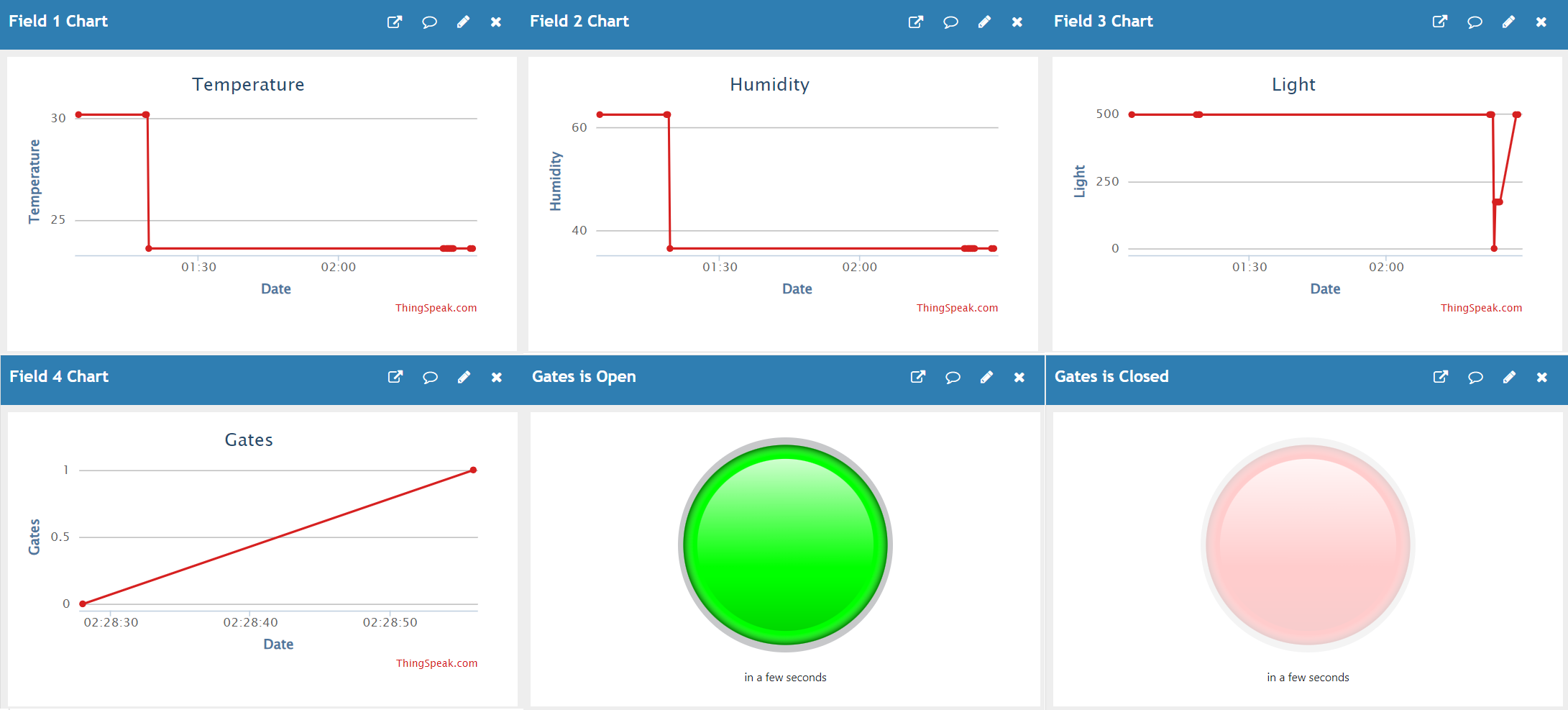
The ThingSpeak platform has many additional features. I briefly describe four of them:
All of them are straightforward, and you just need to click on the appropriate button and fill in gaps in a template with your channel specifications. Below, I post a couple of screenshots.
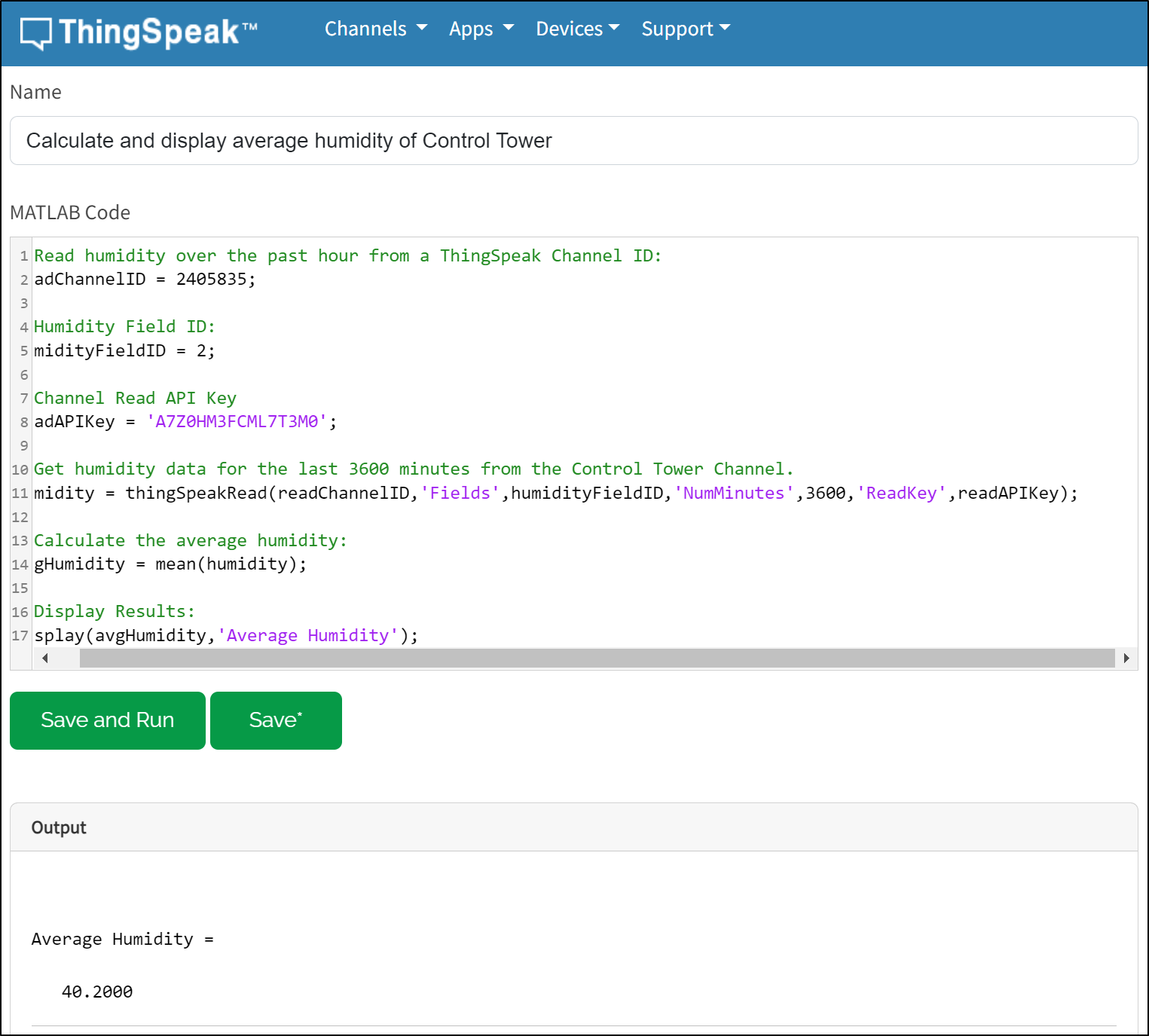
Code:
% Read humidity over the past hour from a ThingSpeak Channel ID:
readChannelID = 2405835;
% Humidity Field ID:
humidityFieldID = 2;
% Channel Read API Key
readAPIKey = 'A7Z0HM3FCML7T3M0';
% Get humidity data for the last 3600 minutes from the Control Tower Channel.
humidity = thingSpeakRead(readChannelID,'Fields',humidityFieldID, 'NumMinutes',3600,'ReadKey',readAPIKey);
% Calculate the average humidity:
avgHumidity = mean(humidity);
% Display Results:
display(avgHumidity,'Average Humidity');
% Channel ID to write data to:
writeChannelID = 2406151;
% Enter the Write API Key between the '' below:
writeAPIKey = '34UF5KAH58EBRN5Q';
% Write average humidity to another channel
thingSpeakWrite(writeChannelID,avgHumidity,'WriteKey',writeAPIKey);
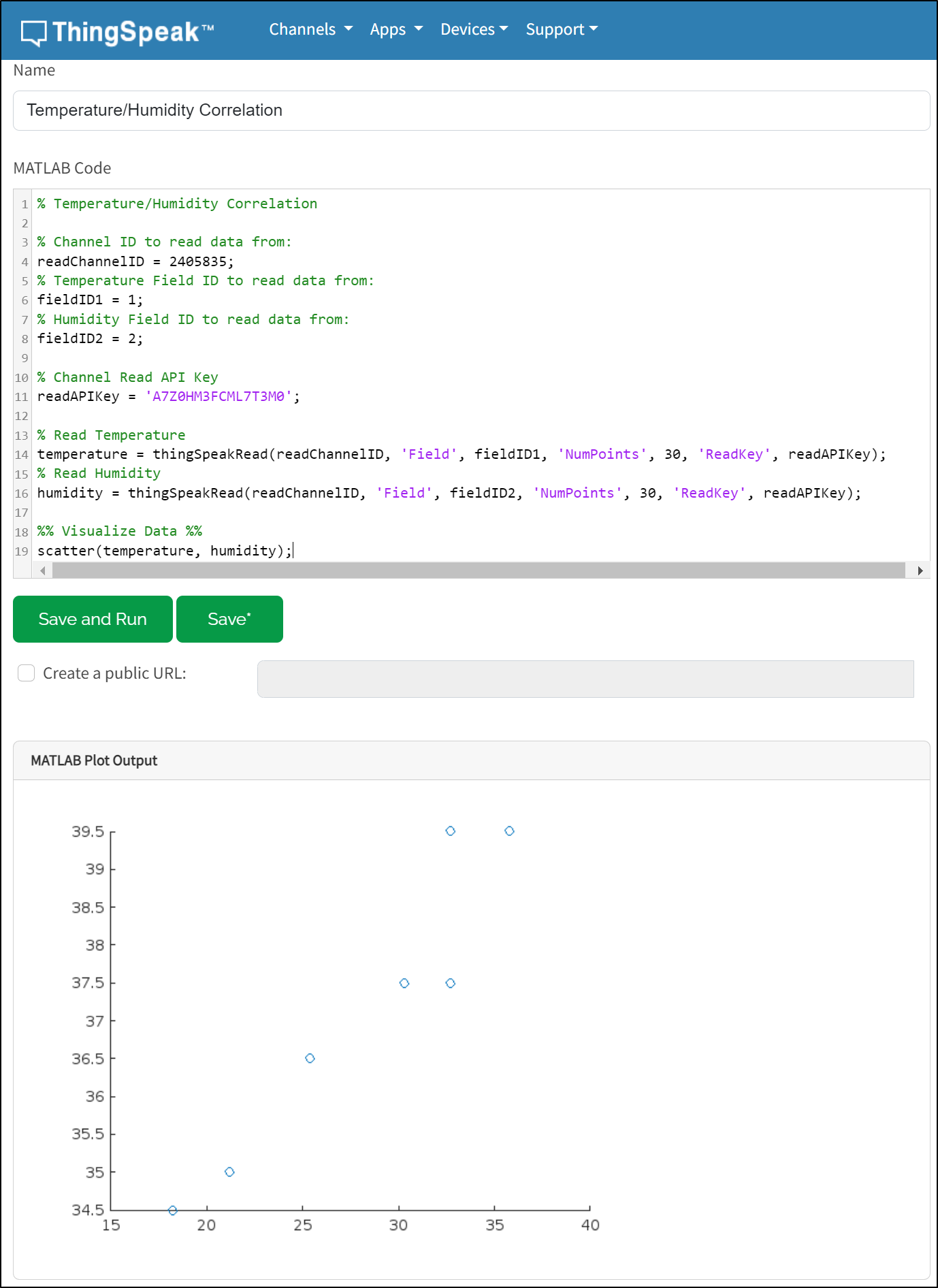
Code:
% Temperature/Humidity Correlation
% Channel ID to read data from:
readChannelID = 2405835;
% Temperature Field ID to read data from:
fieldID1 = 1;
% Humidity Field ID to read data from:
fieldID2 = 2;
% Channel Read API Key
readAPIKey = 'A7Z0HM3FCML7T3M0';
% Read Temperature
temperature = thingSpeakRead(readChannelID, 'Field', fieldID1, 'NumPoints', 30, 'ReadKey', readAPIKey);
% Read Humidity
humidity = thingSpeakRead(readChannelID, 'Field', fieldID2, 'NumPoints', 30, 'ReadKey', readAPIKey);
%% Visualize Data %%
scatter(temperature, humidity);
